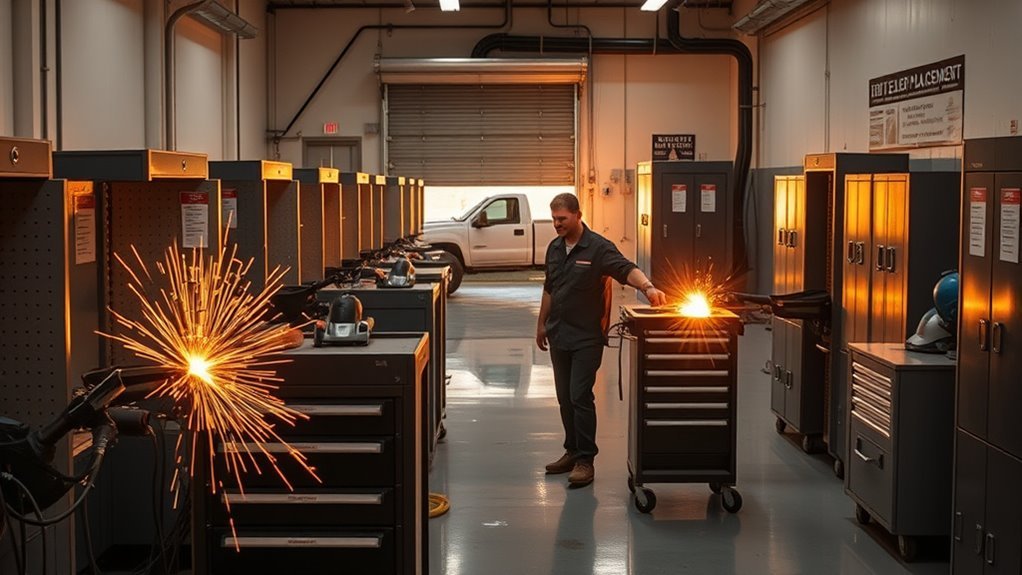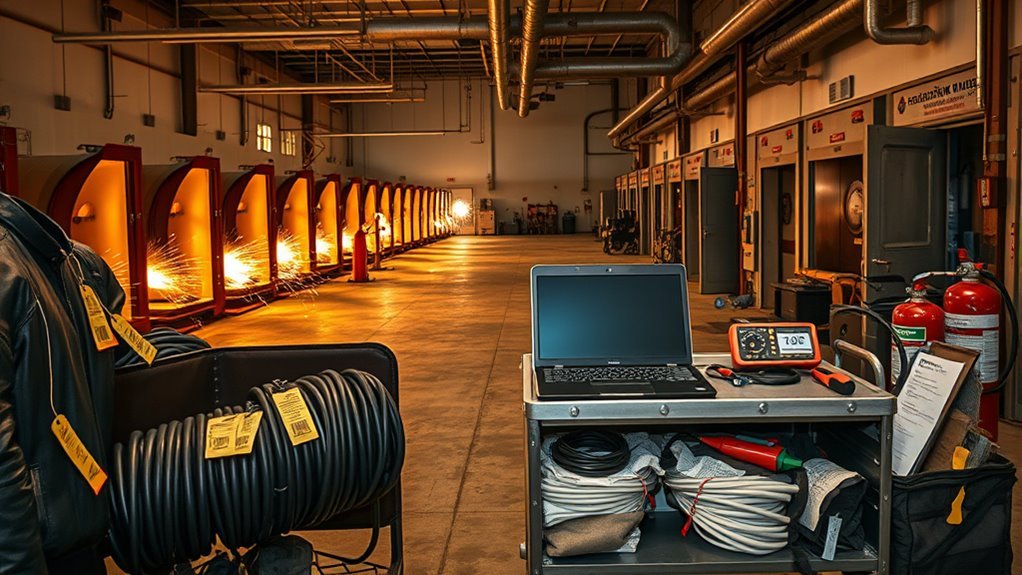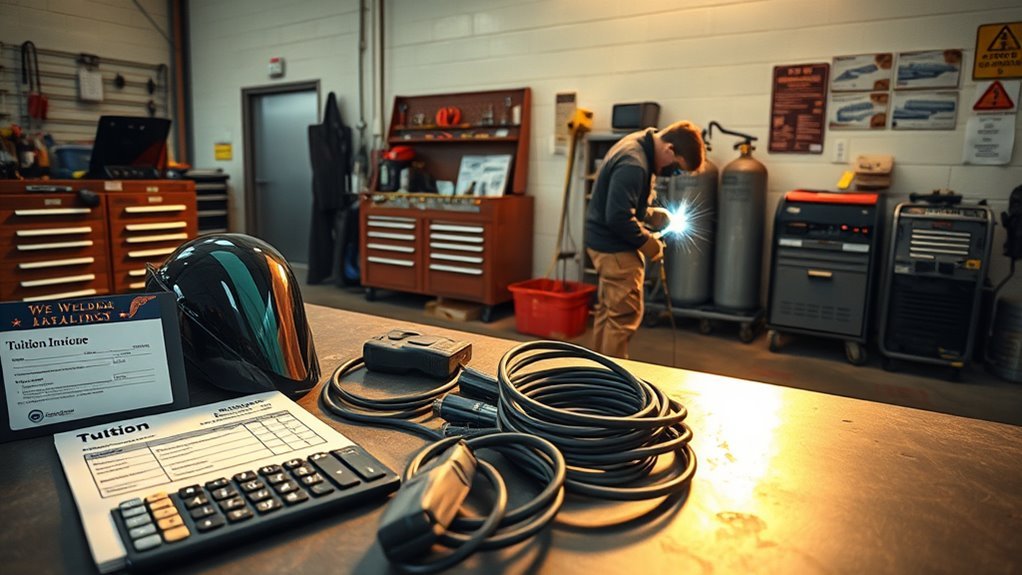You’ll typically pay about $3,000 if you qualify for in‑state rates and around $6,000+ if you’re out‑of‑state, with core tuition often covering labs and some gear. Expect mandatory lab fees, tools, books and insurance to add $1,500–5,000 depending on the program. Short certificates cost less; advanced specialist tracks can total $20k–30k with living expenses added. Use FAFSA, scholarships and VA benefits to lower costs — keep going to see sample breakdowns and funding tips.
Typical Tuition Rates for In-State and Out-of-State Students

While costs vary by school, you can generally expect in-state welding programs in Oklahoma to run about $3,120, with out-of-state rates near $6,240; plan on roughly $75 more for supplies, though many schools provide books at no extra charge.
You should weigh in state advantages like lower tuition, easier access to state-funded grants, and eligibility for residency-based discounts.
Weigh in-state benefits: cheaper tuition, easier access to state grants, and residency-based discounts.
Out of state challenges include doubled tuition and potential extra fees or residency requirements.
Look for tuition-free options for high school students and check VA Educational Benefits or other financial aid that can cut your net cost.
Compare net price, not just sticker price, and confirm which supplies or fees the school actually charges before you enroll.
Program Lengths: From Short Certificates to Advanced Tracks

You’ll find welding certificates and diplomas ranging from about seven months up to a year, with some high school Combination Welder I courses at 480 hours.
If you’re aiming for advanced skills, expect programs around 960 hours or specialized tracks like Welding Specialist with Pipefitting at roughly 9½ months.
Choose shorter certificates for quick entry into the workforce or longer advanced tracks for higher pay and broader job opportunities.
Certificate and Diploma Durations
When choosing a program, match your schedule and goals to program length: you can finish a Professional Welding certificate in about seven months at several Oklahoma campuses, enroll in a 480-hour Combination Welder I course as a high school student, take a 9½-month Welding Specialist with Pipefitting track at Jacksonville or Houston, or pursue advanced 960-hour programs—adults typically complete full-day tracks in one year or half-day tracks over two.
| Program | Typical Duration |
|---|---|
| Professional certificate (certificate options) | ~7 months |
| Combination Welder I (high school) | 480 hours |
| Welding Specialist w/ Pipefitting | 9½ months |
| Advanced programs (diploma types) | 960 hours / 1–2 years |
Pick the shortest credential that meets employer expectations; choose longer diplomas for broader skills and higher pay potential.
Advanced Track Timelines
After you match program length to your schedule and goals, look at the timelines for advanced tracks to pick the level that fits your career plan.
You can finish the Professional Welding program in as little as seven months at several TWS Oklahoma campuses, a good short-certificate option if you want quick entry into the field.
The Welding Specialist with Pipefitting runs about 9½ months (Jacksonville and Houston campuses) and targets piping work.
High school Combination Welder I delivers 480 hours across multiple techniques for early exposure.
Adult pathways vary: one year full-day or two years half-day for deeper skill development.
The Advanced Welding Program totals 960 hours, covering advanced training, cutting techniques and blueprint reading.
Use program comparisons to choose depth versus speed.
What’s Included in Tuition at Oklahoma Welding Schools

When you review tuition, look at the line items so you can compare base tuition, lab fees, and technology charges like the $500 VR fee.
Check what’s bundled—gear packages, textbooks (usually $350–$400), and a $2,000 lab fee are often included in the total.
Also confirm included services such as accident insurance and hands-on training so you’re not hit with surprise costs.
Tuition Line Items
You’ll find that tuition at Oklahoma welding schools usually covers more than classroom instruction—expect core tuition to include hands-on lab time, safety gear, and certain fees tied to training technology and insurance. For a clear tuition breakdown and the financial implications, compare line items so you know what you’re paying for: base tuition, lab fees, gear, tech fees, and accident insurance. TWS example totals help you budget: Welding Specialist tuition $18,700 plus $2,000 lab, $1,800 gear, $500 tech fee, $300 insurance, plus $350–$400 materials equals $23,650 total. Use the table below to spot major cost drivers and prioritize funding or aid options.
| Item | Cost | Notes |
|---|---|---|
| Tuition | $18,700 | Core program |
| Lab & Gear | $3,800 | Hands-on experience |
Supplies and Gear
Although tuition often covers classroom time and lab access, you should check precisely which supplies and safety gear are included so you don’t face unexpected costs.
At TWS the Welding Specialist tuition ($18,700) includes lab fees and accident insurance, and a gear package—gear essentials like helmets, gloves, and leathers—amounts to about $1,800 as part of that total.
Expect course materials and textbooks to add roughly $350–$400 unless those are separately provided.
If you enroll in Welding Specialist with Pipefitting, total costs rise to about $22,700 because additional supplies are required.
For clear supply management, get an itemized list from the school, compare what you already own, and budget for replacements and consumables before classes start.
Included Services and Fees
Because tuition numbers can hide additional costs, check exactly what’s bundled into the price before you enroll. You’ll want a clear tuition breakdown and program comparison so you can compare TWS’s Welding Specialist ($18,700) and Welding Specialist with Pipefitting ($22,700). Don’t forget mandatory extras: lab fee ($2,000), accident insurance ($300), VR tech fee ($500), and gear packages that bring totals to $23,650 and $29,150 respectively.
| Item | Welding Specialist | With Pipefitting |
|---|---|---|
| Base tuition | $18,700 | $22,700 |
| Lab fee | $2,000 | $2,000 |
| Insurance & tech | $800 | $800 |
| Total (with gear) | $23,650 | $29,150 |
Also budget $350–$400 for books and $1,000–$1,500/month living if you commute.
Additional Fees: Lab, Gear, and Technology Costs

When budgeting for welding school in Oklahoma, account for several mandatory extras: lab fees run about $2,000 for hands-on instruction, a required gear package is roughly $1,800 (usually bundled into tuition), technology fees for VR training add $500, accident insurance is about $300, and books/materials cost $350–$400—so plan for roughly $4,950–$5,000 in additional fees beyond base tuition.
You’ll want to confirm whether that lab equipment fee covers consumables, machine maintenance, and shop access outside scheduled hours.
Check the gear package details so you don’t duplicate purchases; it often includes helmets, jackets, gloves, and respirators tied to safety training standards.
Ask programs about VR license periods, replacement policies for damaged gear, and whether any small tools or certification exam fees are extra.
Estimated Total Cost: Sample Program Price Breakdown

Now that you know the common extra fees to expect, let’s look at what a full program actually costs so you can budget realistically.
A Welding Specialist program at TWS runs about $23,650, covering tuition, lab fees, a gear package and accident insurance. If you choose Welding Specialist with Pipefitting, plan on roughly $29,150 for the added training.
High school students often attend tuition-free; out-of-district adults might pay about $5,280 plus fees and supplies. Supplies and welding equipment can total up to $6,696 and are a major part of cost.
Don’t forget monthly living expenses — rent and transportation often add $1,000–$1,500 for commuting students. Use these figures for practical financial planning.
Financial Aid Options: Grants, Loans, and VA Benefits
You can cut your out‑of‑pocket cost with grants and scholarships that don’t need repaying, so start by searching school, state, and private awards.
Complete the FAFSA to see if you qualify for federal student loans and need‑based aid, and use each school’s Net Price Calculator to estimate your actual cost after aid.
If you’ve served, check VA and military education benefits eligibility to cover tuition and fees and combine funding sources as needed.
Grants and Scholarships
Although financing a welding program can feel intimidating, grants and scholarships can slash your out-of-pocket costs because they don’t need to be repaid; thousands of awards target welding students and many schools and employers offer program-specific aid.
Start by completing the FAFSA to check grant eligibility and access federal, state, and institutional funds. Use school Net Price Calculators and department pages to find scholarship opportunities and deadlines. Veterans should contact the VA office for education benefits tailored to welding programs.
- Search local trade foundations and employer-sponsored scholarships—apply early and often.
- Prioritize grants found via FAFSA and state aid before considering paid options.
- Track award terms and renewal criteria to maintain funding through your program.
Federal Student Loans
When federal grants don’t cover everything, federal student loans can bridge the gap for welding school tuition and fees, which in Oklahoma often range from about $2,640 to $6,240 depending on residency. You should file the FAFSA to see your federal assistance options and confirm Title IV eligibility at your chosen school. Loans give predictable funds but require loan repayment; weigh interest rates and terms before borrowing. Use grants and scholarships first, then take only what you need in loans. Keep borrowing records and ask your school’s aid office about repayment plans and consolidation. Compare federal loans to private alternatives only after maximizing federal assistance and understanding protections like income-driven repayment.
| Item | Purpose | Note |
|---|---|---|
| FAFSA | Determine aid | Required |
| Loan | Cover shortfall | Repayment |
| Grant | Free aid | No repayment |
| School aid office | Guidance | Ask early |
VA and Military Benefits
If you’re a veteran or active-duty service member, VA education benefits can substantially lower or even cover welding school costs in Oklahoma, so check program eligibility and apply through the VA early.
You’ll find many Oklahoma welding programs accept VA benefits and support military education pathways, often reducing the net price via grants and scholarships that don’t require repayment.
Use FAFSA to see federal aid options and compare grant vs. loan needs.
- Confirm school certification and submit your VA benefits application early to avoid delays.
- Seek grants and scholarships first — they cut costs more than loans and some schools report little to no graduate loan debt.
- Combine VA benefits with FAFSA-awarded aid for the lowest out-of-pocket expenses.
Scholarships and How to Find Them
Wondering how to cut your welding school bill? Thousands of scholarships exist for welding students, and you can use a scholarship search feature to match opportunities to your background and skills.
Check scholarship eligibility carefully—some target veterans, low-income students, or specific certifications. Complete the FAFSA so colleges can include federal aid in your financial aid package; need-based grants may appear alongside scholarships.
Check scholarship eligibility carefully—some target veterans, low-income students, or specific certifications. Complete the FAFSA to reveal need-based grants.
Contact the financial aid office at your chosen school for tailored leads and deadlines. Gather strong application materials: transcripts, résumés, references, and clear application tips like customizing essays, meeting deadlines, and following formatting instructions.
Remember grants and scholarships don’t require repayment, so prioritize them before loans. Consistent searching and organized applications will greatly reduce your out-of-pocket cost.
Living and Transportation Expenses to Budget For
Because living and travel can add several hundred dollars a month to your welding program costs, plan a realistic budget before classes start: commuting students typically face $1,000–$1,500 monthly rent plus about $300 in travel, while independent students should expect roughly $10,654.20 annually for food and housing.
You’ll need to factor in who provides transportation and whether afternoon sessions require you to arrange your own. Consider tool approval and variable tool costs separately.
- Compare living costs: weigh on-campus or shared housing vs. independent living to meet that $10,654.20 estimate.
- Assess transportation options: carpool, public transit, or fuel and parking for commuting students.
- Budget contingency: set aside extra for unexpected travel or housing changes.
Career Outcomes and Return on Investment
While upfront tuition and supplies can push your program cost toward $9,000 or more, hands-on training in Oklahoma welding programs often leads quickly to paid work — many grads land entry-level jobs paying roughly $30,000–$50,000 a year depending on experience and specialty.
You’ll find that practical labs and employer connections shorten the path to employment in manufacturing, construction, and energy. Given current demand, welding careers offer clear salary expectations and steady hiring, with chances to advance into supervisory or technical roles that raise pay.
Use scholarships, VA benefits, and local aid to lower your net expense so your ROI improves. If you focus on certifications and specialties employers want, you’ll increase hiring odds and future earnings.
How to Calculate Your Net Price and Next Steps
If you want a realistic cost picture, start by calculating your net price: take the school’s total cost of attendance (tuition, fees, supplies, and living expenses) and subtract any grants or scholarships you expect to receive.
Use the college’s Net Price calculator for a tailored estimate, then complete the FAFSA to access need-based financial aid. Contact the financial aid office to confirm deadlines and document requirements.
- Use the school’s Net Price calculator and list expected grants/scholarships to estimate your net price.
- File the FAFSA promptly; grants don’t require repayment and can lower your out-of-pocket cost.
- If gaps remain, compare loan terms, payment plans, and ask the aid office about additional institutional aid.
Frequently Asked Questions
Do Employers Help Pay for Welding School Tuition?
Yes — you can often get tuition reimbursement or employer sponsorship for welding school; you’ll need to negotiate or qualify through apprenticeships, performance, or company training programs, and confirm repayment rules, timelines, and any service commitments.
Can I Transfer Welding Credits Between Oklahoma Schools?
Yes — you can often transfer welding credits between Oklahoma schools, but it depends on credit transfer policies and inter school agreements; you’ll need official transcripts, course syllabi, and advisor approvals to confirm equivalency and acceptance.
Are Night or Weekend Welding Classes Available?
About 70% of programs offer evening classes, so you can usually find night or weekend welding courses; you’ll get practical guidance on flexible scheduling, choose sessions that fit your work, and balance hands‑on labs with shifts.
Do Schools Provide Job Placement or Internship Assistance?
Yes — many schools offer job placement and internship programs; you’ll get resume help, employer connections, and hands-on placements. Ask schools about placement rates, partner companies, and whether internships count toward certification or credit.
Is Certification Testing Included Beyond Basic Exams?
About 60% of programs charge extra; you’ll usually pay certification costs separately. Check testing options—school-run exams, third-party AWS testing, or proctoring services—so you can budget, schedule, and prepare for specific credential requirements.
Conclusion
Think of choosing a welding program like picking the right torch for a job: one student I know spent $6,200 on a certificate, and that focused investment cut his job search to two weeks. You’ll want to match cost, program length, and included gear to your goals so you’re not overpaying for heat you don’t need. Use scholarships, compare net price, and plan living costs—then pick the torch that fits your work.


